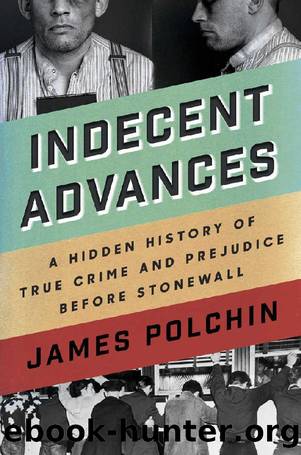Indecent Advances: A Hidden History of True Crime and Prejudice Before Stonewall by James Polchin

Author:James Polchin [Polchin, James]
Language: eng
Format: epub
Tags: 20th Century, Gay Studies, GLBT, History, Media Studies, Non-Fiction, Social History, Social Science, United States
ISBN: 9781640091900
Google: 4V17DwAAQBAJ
Amazon: B07H4N1R4T
Publisher: Counterpoint
Published: 2019-06-03T23:00:00+00:00
“THE PROWLERS AND THE EXHIBITIONIST, THE BLATANT ACCOSTERS LOOKING FOR PICKUPS”
“Once a man assumes the role of homosexual,” wrote the editors of Coronet, a widely circulated magazine, in 1950, “he often throws off all moral restraints,” adding that such men “descend through perversion to other forms of depravity, such as drug addition, burglary, sadism, and even murder.”63 This progressive model of perversion, in which antisocial behavior spirals toward ever-increasing, dire forms of violence, was a prevalent idea in popular magazines and newspaper articles about sex crimes in the late 1940s.
As in the 1930s, the late 1940s witnessed renewed legislative actions on policing and treating the category of criminality known as the sexual psychopath. Across the country, states and cities enacted new sexual psychopath laws that conflated a host of behaviors, from rape and exhibitionism to public masturbation, sex with minors, public sex, and sodomy. In the years after the war, twenty-one states and the District of Columbia passed new laws aimed at such criminality.64 Such laws often mandated broader surveillance and policing efforts of sexual deviants that disproportionally focused on queer men’s visibility and activities in public. In Philadelphia in 1950, for example, police were arresting approximately two hundred men a month on charges of disorderly conduct or public indecency, numbers that the courts were struggling to handle.65 While such arrests often targeted harmless interactions between queer men in public, the effect of such policing was to increase rates of arrests of “sex perverts,” which in turn gave the impression that the city was being overrun with sexual deviants.
As he did before the war, FBI Director J. Edgar Hoover stoked such fears by writing dire articles warning about the safety of children. In “How Safe Is Your Daughter?” published in The American Magazine in 1947, Hoover fostered a fevered fear of sexual deviancy and the threat of a sexual psychopath around every corner. “The wartime spirit of abandon and ‘anything goes,’” Hoover wrote, “led to a decline in morals among people of all ages.”66 In another article, this one from the early 1950s, Hoover would claim “the sex offender has replaced the kidnapper as a threat to the peace of mind of the parents of America.”67
In Hoover’s own Washington, D.C., concerns about sex crimes reached a fevered pitch in the late 1940s as Senator Joseph McCarthy was organizing his purges of Communists and homosexuals from the federal government. A 1947 editorial in The Washington Post echoed sentiments found across the country when it argued for a “comprehensive sex crime law” to protect “the people of the community.” Noting that while “forty-seven states now have such laws,” the city relied on “obscure common law provisions on sodomy.” In its focus on sodomy, the editors betrayed the underlying motive for tougher sex crime legislation: more surveillance and arrests of queer men across the city. “Washington,” the editorial claimed, “has become more or less a haven for sexual perverts and degenerates.” While recognizing that some sexual perverts could be changed through psychiatric treatment, and supportive of suggestions that all sex offenders be “committed to St.
Download
This site does not store any files on its server. We only index and link to content provided by other sites. Please contact the content providers to delete copyright contents if any and email us, we'll remove relevant links or contents immediately.
| African-American Studies | Asian American Studies |
| Disabled | Ethnic Studies |
| Hispanic American Studies | LGBT |
| Minority Studies | Native American Studies |
Cecilia; Or, Memoirs of an Heiress — Volume 1 by Fanny Burney(31332)
Cecilia; Or, Memoirs of an Heiress — Volume 3 by Fanny Burney(30934)
Cecilia; Or, Memoirs of an Heiress — Volume 2 by Fanny Burney(30889)
The Great Music City by Andrea Baker(21313)
We're Going to Need More Wine by Gabrielle Union(18072)
Bombshells: Glamour Girls of a Lifetime by Sullivan Steve(13108)
Pimp by Iceberg Slim(12931)
All the Missing Girls by Megan Miranda(12747)
Fifty Shades Freed by E L James(12451)
Norse Mythology by Gaiman Neil(11883)
Talking to Strangers by Malcolm Gladwell(11876)
Crazy Rich Asians by Kevin Kwan(8349)
Mindhunter: Inside the FBI's Elite Serial Crime Unit by John E. Douglas & Mark Olshaker(7834)
The Lost Art of Listening by Michael P. Nichols(6473)
Enlightenment Now: The Case for Reason, Science, Humanism, and Progress by Steven Pinker(6405)
Bad Blood by John Carreyrou(5769)
The Four Agreements by Don Miguel Ruiz(5511)
Weapons of Math Destruction by Cathy O'Neil(5036)
We Need to Talk by Celeste Headlee(4868)
